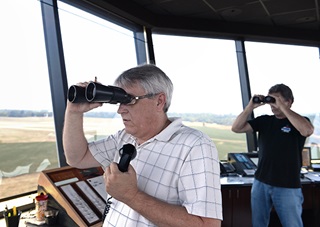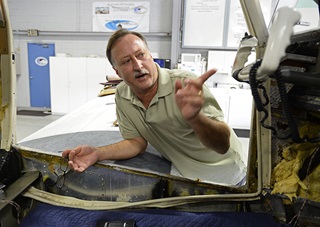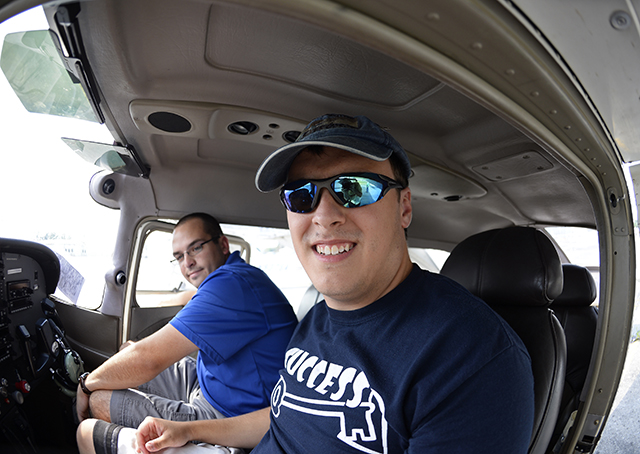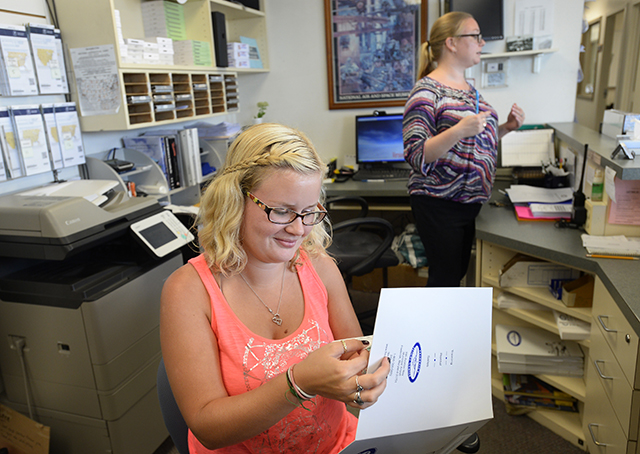When Danny Croy pulled back on the yoke from his perch in the left seat of a Cessna 172, his face revealed a confidence that often escaped the autistic 19-year-old. Croy is not comfortable with significant changes in routine, but he methodically followed the advice from Frederick Flight Center instructor Tyler Stanis seated beside him for his fixed-wing discovery flight over central Maryland.
“I anticipated him doing the rotation but I was ready, just in case,” said Stanis, 23. “As our airspeed came up, I looked over from the right seat and sure enough he got us airborne and headed upwind with a big smile. He was afraid at first because he doesn’t drive a car. So I showed him how easy it was and then he took over.”
The joy that Croy felt as he pierced the cobalt blue Maryland sky wouldn’t have been possible without a team of people working behind the scenes at Frederick Municipal Airport, home of AOPA in Frederick, Maryland. An army of airport employees keeps the airport running smoothly and helps make experiences like this happen.
Frederick Flight Center front desk personnel Natalie Cox and Katherine McClinton had matched Croy with an instructor and juggled schedules to locate an aircraft so the young aviator could get airborne. Stanis had checked the fuel tanks and called for a top-off of avgas. Landmark Aviation line service technician Mohamad 'Mo' Gueye sprang into action after his truck radio crackled with Stanis's request.

Meanwhile, Frederick air traffic controllers lifted powerful binoculars to their eyes and handsets to their ears to communicate with pilots in the airport pattern and on the ground. Like other tower controllers across the United States, Todd Johnson and the Frederick team also relay clearances for instrument flight plans, record hourly weather reports, and negotiate ground movements on the field. For transient pilots and students alike, Johnson said his crew is there to help out: “Just let us know if you are unfamiliar with the area and we can give you instructions and point you in the right direction.”
Assistant airport manager Nick Sabo had already supervised a team of mowers making one of their regular grass-cutting rounds. “The mowers are out here about twice a month during the growing season to keep lighting and signs visible to pilots and also to discourage habitats that could foster small animals or raptors leading to aviation hazards,” said Sabo.
Tucked away behind a row of faded silver hangars, rotorcraft and fixed-wing FAA designated pilot examiner Neal Lanning, who is also a mechanic and a pilot, supervised an aircraft restoration at his Advanced Helicopter Concepts facility. The multi-tasking Lanning said he administers about 10 checkrides a month to fixed-wing and rotorcraft pilots, including many from the local flight school. “I gave one of Tyler Stanis’s students a checkride recently and he was an outstanding pilot,” Lanning said as he rushed to a meeting before the approach of the busy Labor Day holiday weekend.

Stanis and Croy finished their discovery flight with gentle turns while Croy identified the verdant Monocacy River and Maryland Route 144 below, and Stanis pointed the Skyhawk toward Frederick Municipal Airport for a landing, listening to the ATIS report and sighting the PAPI lights near the freshly mowed grass at Runway 23. Hovering near the flight school’s front desk, Croy’s father Elton beamed with pride as the Cessna touched down with his son while Cox and McClinton answered the telephone and dispatched another wave of pilots.
“We do it because we like doing it, but it’s not for the money," Lanning said, expressing a sentiment that many general aviation airport personnel share. “We do it because we love what we do.” And doing so gave Croy the opportunity of a lifetime.









